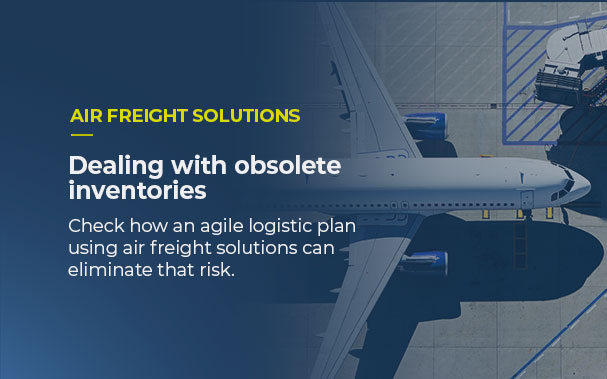Learn how you can balance inventory costs and mitigate the risks of obsolete inventory adopting air freight solutions on your logistics plans.
One of the main challenges for the ones responsible for keeping a global supply chain running is to find the balance point between supply and demand.
To get there, it might seem like a bold idea to maintain higher inventories on the floor, to be able to react fast to any fluctuation in demand.
However, this is not as simple as it seems. It is important to consider two fundamental elements in this type of decision:
- The expiration
- The products’ obsolescence
When we talk about expiration, we refer to the shelf life of your product, which is determined and validated by its producer. All products – including machinery and tools – have an expiration date.
Obsolescence refers to inventories that, although not necessarily have fulfilled their shelf life, represents a risk to the company, due to the high potential of not being used or sold.
Obsolete inventories regularly originate from:
- The purchasing minimums determined by the suppliers,
- Poor planning practices and
- Unplanned decreases in demand.
With the intention of reducing the risk of obsolete inventories, companies usually stablish obsolete inventory turnover policies.
In the manufacturing industry, obsolete inventories can be defined as those materials that are over than 60, 90 and 180 days old.
Impact to costs
The first impact that we can identify with expired and/or obsolete inventories is the cost of discarding, which is calculated by the sum of:
- Acquisition costs: All costs associated with the purchase of the material. They include logistics, customs, warehouse, etc.
- Operating costs: Costs associated with the management of inventories in warehouse related to the receipt of material, quality analysis (application of tests, etc.) and the cost of handling in the warehouse.
- Costs of inventory destruction: Related to resources (personnel, equipment, time) dedicated to this extreme action.
In addition to the costs described above, it is important to also keep in mind the opportunity cost, which is linked to the possibility of having allocated some financial and operational resources (time and resources dedicated to the handling of this merchandise) that could have been dedicated to other activities – or other areas of the company.
Maintaining high inventory levels in warehouse involves much more than the cost of acquisition (which has a direct impact on cash flow), since it also implies a high operating cost due to the allocation and management of anticipated resources to a necessity that is not immediate or short-term.
You should also read: optimize your inventories choosing air freight solutions
It is impossible for industries to eliminate expired or obsolete inventories. However, designing shorter logistics plans, using air freight solutions to transport your most sensitive products reduces that risk and its associated costs.
Inventory optimization: an example
In this article, let’s think about a manufacturing company within the food sector.
The company SM(FL) is dedicated to manufacturing flavors and dyes for the food industry. Due to their products’ degree of specialization, they have developed specific formulas for each of their customers.
One of his most relevant customer orders him, every 2 months, a “strawberry flavor” and every 3 months a “low sugar strawberry flavor”, which they use to make bread.
It is important to notice that amount of flavor used in food products is very small and generally it is usually expensive.
SM(FL) planning team has identified that the formulas of these flavors are not simple; they contain more than 20 ingredients each and, although they share ingredients in their entirety, they are 30 exclusive raw materials with a high cost.
Additionally, most come from the United States and Europe. The minimum purchase of each ingredient varies between 20 and 25 kilograms and the average shelf life is between 30 and 50 days.
Everything seems to get even more complicated because 5 ingredients are classified as dangerous products (chemicals).
SM(FL) has more than 200 active customers to whom it sells flavors of very similar characteristics for its finished products. Some of these customers consume large quantities and others consume small amounts.
They have many suppliers – some are more strategic, as they provide several critical raw materials.
Reflection:
What decisions should SM(FL) to accomplish inventory optimization avoiding expired or obsolete products?
How could air freight solutions help these buyers reduce their risks?
The organization process
With the correct logistics advice, SM(FL) could reach inventory optimization hand in hand with its logistics partner by:
- Consolidating their purchase orders from each of their suppliers to negotiate optimal costs and delivery dates
- Consolidating their purchase orders with the same origin, to coordinate shipment departures in an organized way
- Assessing the cost-benefit of air freight vs ocean freight solutions, from the perspective of delivery dates and potential obsolescence of inventories on the high seas
Why should you choose Europartners Group air freight services for your inventory optimization strategies?
With 20 years of experience in the global logistics market, we specialize in air freight and urgent time-sensitive solutions.
In addition to multimodal alternatives, we offer comprehensive logistics advisory services and professionals dedicated to your company, with key account managers and in-house solutions.
We also have air freight consolidation services from different parts of the world to guarantee you spaces.
Connect with us. We are Europartners Group. Connecting minds to move the world.
 ESPAÑOL
ESPAÑOL





